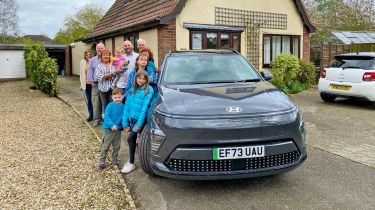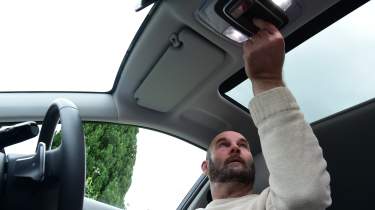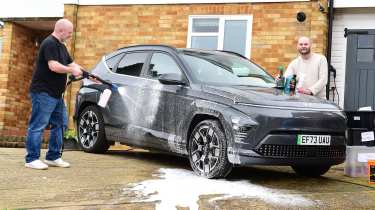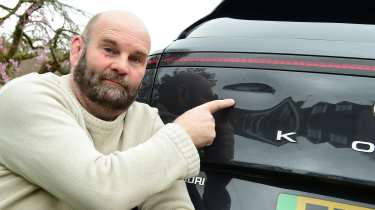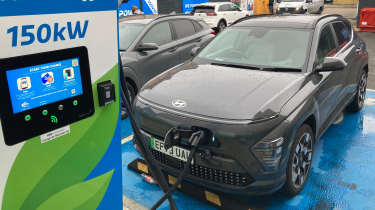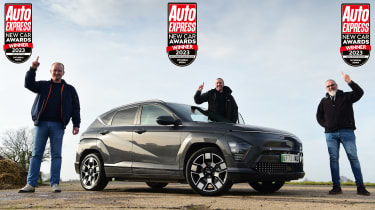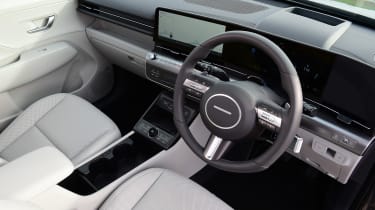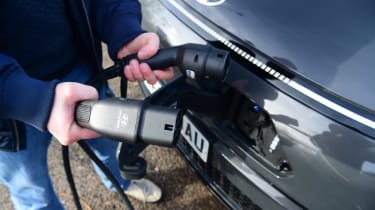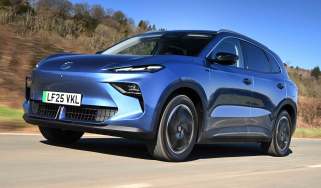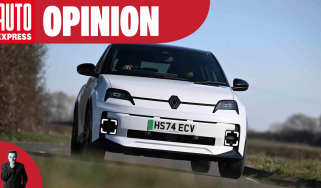Hyundai Kona Electric Ultimate long-term test: our Car of the Year continues to impress
Final report: our electric SUV again shows why it was our Car of the Year in 2023
Verdict
The Hyundai Kona is a cracking SUV with much to like. The Hyundai’s in-car tech is easy, with simple displays and good safety equipment that’s not intrusive. The car isn’t that exciting to drive, but it’s good for families.
- Mileage: 2,330 miles
- Efficiency: 3.2 kWh
I’ve had very few issues with the Auto Express 2023 Car of the Year. In fact I’ve struggled to think of things I don't like about it. For the record, contenders included the alert sounds, bings and bongs that might annoy a few drivers, but they only come with overly aggressive driving or speeding. Also, as the car prepares to return to Hyundai, the predicted range still only reads 245 miles after a full charge.
That is some way short of the 319 WLTP figure Hyundai quotes. But the Kona is quite conservative in its estimate, plus I have only been running the car from January to April, so I would expect the figure to be lower now than in the summer. Mind you, the weather doesn’t seem to have had a big affect on the range on our Volkswagen ID.3.
Anyway you can still do a fair bit with 245 miles of range, as I discovered on a recent weekend away in Lincolnshire visiting family with my wife and grandchildren Zack and Hope. Their safe, but very large ISOFIX car seats take up much of the rear bench, so there was no possibility of bringing either of my grown-up sons along as well.
Used - available now
Driving any kind of distance with little ones requires planning and packing. Luckily, with 466 litres of boot space, the Kona took bags, cases, coats and a buggy with ease. I did remember to take the charge cable out from the underfloor space (where I usually keep it) before packing, just in case it was required. We also had plenty of room for in-car snacks and drinks in the deep door bins and cubbies.
Our usual route from South London to North Lincolnshire is around 200 miles, with a fair bit of motorway. Based on my current average return of 3.2kWh, that should have been possible in one hit with careful driving. But I was playing it safe and expected to stop once at services to give the children a break and add a few miles of charge to the Kona.
What happened has changed my way of thinking about driving any kind of distance on UK roads these days. We set off and sat in traffic for hours getting out of London, then more traffic on the M11, to the point that the kids and I were getting twitchy. We hadn’t even reached Cambridge services (about 70 miles) in over three hours, so we decided to visit Wimpole Farm, which was signposted from the motorway. Unbeknown to me, it had a set of RAW 7.7kWh charge points, so I could add 57 miles of range to the car for a very reasonable £7.39 (based on 43p per kWh), while we had three hours of fun.
Even better, when we got back into the car, I set the nav for our destination and it took us a direct route on back roads, well away from motorways. Rather than my usual practice of getting to the nearest ‘fast’ road, only to be disappointed by how slowly it actually allows me to drive, we carried on unhindered at a constant 50 or 60mph, which got us to our destination with 124 miles of range left and a healthy 3.9kWh readout for the last 110 miles of our trip.
Was it quick? No, but it was a shorter distance and much more relaxing, with music from the excellent Bose system and crystal-clear directions on both the main infotainment screen and the head-up display. We even opened the sunroof when we got stuck behind some farm traffic. I had to switch to Sport mode, but I could safely and surprisingly quickly overtake it, much to the enjoyment of my passengers.
Arriving at our family stopover with plenty of charge gave us the option to use the car without having to find charge points. I was also able to plug in and top it up using my father-in-law’s outside plug.
Much of that power would have been generated from his solar panels, which was nice for me and generous of him. However, I was a bit disappointed by the charge speed. Topping up overnight, plus for a chunk of the next day, only nudged the range towards 200 miles – not enough to get home in one go. That resulted in a one hour and 15 minute stop at Cambridge services, where we had a snack and let the children run about while topping up at a Gridserve fast charger. Adding 183 miles of range (from 28 to 95 per cent) cost £38.87, based on 79p per kWh.
Again, we arrived at our destination with well over 100 miles of range and enough to easily run the car for a week, based on regular family usage. The Kona once again proved why it won our Car of the Year award and will be missed by me and my family. It was easy, safe, comfortable and trustworthy. I’d happily tackle much longer journeys in the Hyundai, safe in the knowledge that if I take my time, plan ahead and trust the in-car readouts, it’s far more fun than dashing to the nearest motorway traffic jam.
Hyundai Kona Electric Ultimate: second report
Urban taxi, test winner and supermodel - it's all part of the day job for our hi-tech SUV
- Mileage: 1,656 miles
- Efficiency: 3.1 kWh
Unsurprisingly, our 2023 Car of the Year, the Hyundai Kona Electric, made a flying start on the Auto Express fleet. And it recently won another road test, beating the Honda e:Ny1 (on name alone, I reckon).
So what better model to use for our Car Care Special photoshoot than our award winner? Its white-leather interior and trim were ideal for our pictures. To be fair, one of the only criticisms I could pin on the Kona in my first report was the interior material quality. The hard, scratchy plastics felt a little cheaper than I’d expected, but they’ve emerged unscathed from everyday life, so they barely needed a clean.
Likewise the seats remain unmarked, despite two very messy grandchildren and some recent trips to garden centres and even a builder’s yard. White steering wheel and interior? No problem (so far, at least).
I’ve enjoyed getting out and about in our Kona. And with some careful driving, I’ve increased its efficiency to 3.1 miles per kWh, up from 2.8 over the past 1,000 miles.
It isn’t that exciting a car on the road, but it’s not really supposed to be. And although I’m trying to drive economically, I can’t get on with the Eco setting. It’s just too dull, so I drive with the car in its Normal mode.
I have, however, been using the paddle shifts on the steering wheel to adjust the regenerative braking levels, which helps to claw back some range. I find the set-up too harsh in its maximum setting, but using it on the first or second steps helps to extend the range without feeling like I’m fighting to move. On motorways I switch the system off and coast, unless I’m heading downhill.
I’ve found the Kona more fun on country roads and have returned up to 4.0 miles per kWh on some 50-mile runs over a mix of roads. It’s fun – and a challenge – to see what efficiency you can return with a little effort.
However my urban-Grandpa taxi runs sap the range. The eight-mile round trip to my son’s house is equal parts up and downhill, and it doesn’t take a physics degree to work out that, however much power I save going downhill, it takes far more to get the heavy EV back up the same slope on the way back.
Still, the Kona’s projected range is slowly rising with the outside temperature. The latest home charge predicted 256 miles of range (up from 232 miles), so at 3.1 miles per kWh, that’s around 200 miles per charge.
I feel comfortable with the readings and have no range anxiety. Indeed, I’ve driven the car to within 10 miles of its predicted range several times, by which point the Kona has become anxious and started directing me to a choice of charging stations.
I’m lucky enough to have a 150kW fast-change station within a mile of my house (plus a home wallbox). A recent charge at the MFG station boosted the battery from 10 to 80 per cent in 41 minutes, at a cost of £39.61, based on 79p per kWh. A home charge would have been considerably less than half that amount, but I was able to walk to the nearby supermarket and do a family shop while the car was plugged in, which was a good use of the time.
Over the winter months I’ve been able to mostly ignore the climate control and use the heated seats and steering wheel, which are the hottest I’ve ever experienced. This helped boost range. The Kona also has a button to just heat the driver’s side if the windows mist up when I’m driving alone. Other useful buttons include the memory settings for driver’s seat position – ideal for my little and large wife-and-husband combo.
In fact, the Kona is packed with brilliant in-car tech. The head-up display is excellent, with clear info for navigation. This shows two steps ahead, but in arrow or roundabout icon form, with distance readings. It also gives proximity warnings for vehicles approaching, and red lights come on if you are being overtaken or undertaken.
The reversing camera is excellent too, helped by an overhead view and sensors that warn of any obstacles. Even the steering wheel vibrates if I get too close to the tree outside my house, before the brakes kick in to prevent a knock. The same tech stops me reversing into passing traffic in car parks, while cameras in the door mirrors show a view of my blind spot when I indicate.
It all sounds like the Kona is virtually impossible to dent, but sadly I managed it. Being a bit old school and a bit of a know-it-all, I quickly reversed out of a supermarket car park space and hit a rogue shopping trolley in no man’s land. I was looking over my shoulder, not at the reversing screen or overhead view. I can’t remember any beeps, but there must have been some. Maybe I just ignored them because the coast looked clear. Big lesson learned: always use the tech!
As well as these gadgets, I love the Kona’s practicality. There’s loads of room in the back, and the boot is a vast 466 litres, with deep under-floor storage. This is ideal for chucking in charge cables when you want a quick getaway, and sums up the Kona in general. Who doesn’t want an easy life?
Hyundai Kona Electric Ultimate: first report
Our current Car of the Year joins the fleet and immediately shows why it was the team’s number one choice
Mileage: 660 miles
Efficiency: 2.8 kWh
It’s around 30 years since I joined Auto Express, and the first car I was allowed to take for a weekend away was a Hyundai Accent. It was probably the least desirable car on the fleet back in 1994, but goodness me, Hyundai has come a long way since.
The latest arrival on our fleet is the Hyundai Kona Electric, our current Car of the Year – and it’s easy to see why it won. It arrived in December and I’ve hardly had a chance to drive it yet, thanks to a torrent of requests for test and video shoots (coming soon, honest!).
Unlike the previous generation, this Kona was designed and engineered from scratch as a pure electric car and it really looks the part. The dynamic lines across the body mirror those of its big brother (and another Auto Express Car of the Year), the Hyundai Ioniq 5. The single-line ‘lightbar’ headlights look cool and the square pixel rear lights also nod to Hyundai’s electric range. I’m a big fan.
The interior is decent too, but with a few slight drawbacks. Mind you, after six months in the premium all-electric Lexus RZ, I’d find lots of cars suffer in a comparison of interior materials, quality and technology.
The Kona more than holds its own in terms of tech (more on that later), but the materials feel like a mixed bag. The steering wheel and seats are certainly comfortable and suitably soft to the touch, but some of the plastics inside the cabin are hard, scratchy and, if I’m honest, pretty cheap for a car with a list price north of £45,000.
I’m still not totally sold on the brushed-metal effect across the buttons and dash surround, either. Part of me thinks they’re retro cool and a perfect partner for those pixel lightbars. Yet this same effect looks cheap and nasty on the Kona’s key fob.
It is great to have buttons to press on the dashboard, though. Even with two 12.3-inch touchscreen displays, I can still adjust the temperature controls with a press. Likewise, I can select the home screen, navigation, media or car set-up simply with the push of a button, before messing with the screen. It’s ideal, and safer when driving.
Our Kona is packed not only with tech and safety gear, but also some nice luxurious touches. Buyers have three trim levels to choose from (Advance, N Line and Ultimate) and we’ve gone for the range-topper, then added a few options – namely metallic paint, plus the Lux pack, which brings features such as a memory seat, remote parking assist and, of all things, a heated charging door. As standard, our car also gets heating on the front and rear seats, plus the steering wheel, along with a wireless phone charger and an upgraded Bose stereo.
All of this pushes the list price up from £34,995 for a standard 48kWh Kona in Advance trim to the aforementioned £45,345 for our 65.4kWh long-range Ultimate.
Our Kona is supposed to have a range of around 319 miles between charges. But the most that I’ve managed to get it to display so far is 242, then 232 miles after the last two overnight charges from my home wallbox. I put that down to January temperatures and expect it to rise as the weather improves.
All Kona Electrics come with a heat pump, which aims to help warm the car without decimating the range. It seems to work, too; even with the heating blasting out on colder mornings, the range falls far less quickly than in my old Lexus.
Early impressions are that the Kona Electric is an easy car to drive, set up for comfort rather than performance. It doesn’t feel heavy like some EVs, though, and it’s quite agile, without being sporty. Plus it’s quick enough about town – and refined.
There is an exhaustive list of safety tech fitted, and I’ll explore that more in a future report, but Hyundai allows the driver to actually drive; the tech is supportive and doesn’t impose itself with as many alerts and beeps as in some cars. Plus there’s always the option to further fine tune which alerts are required among the settings.
I have no issues with practicality either. With 466 litres of boot space, plus decent underfloor storage, it’s more than enough for my family. There’s plenty of room in the rear for three adults or two large child seats.
An interesting final point is people’s perceptions of brands. A couple of family members have mentioned that it must be
a comedown to switch from a Lexus to Hyundai. “Far from it”, is my reply.
I’m much more comfortable in the Kona, which is more my level: a fair bit cheaper, less ostentatious and still with most of the bells and whistles (but without the beeps). Once those same family members have had a lift, they might see how far Hyundai has come since the days of that Accent.
| Model: | Hyundai Kona Electric 65.4kWh Ultimate |
| On fleet since: | December 2023 |
| Price new: | £43,095 |
| Powertrain: | 65.4kWh battery, 215bhp motor |
| Options: | Lux pack (£1,600), metallic paint (£650) |
| Insurance*: | Group: 33/Quote: £717 |
| Mileage: | 2,330 miles |
| Range: | 319 miles (claimed) |
| Efficiency: | 3.2 kWh (on test) |
| Any problems? | None so far |
*Insurance quote for a 42-year-old in Banbury, Oxon, with three points.

